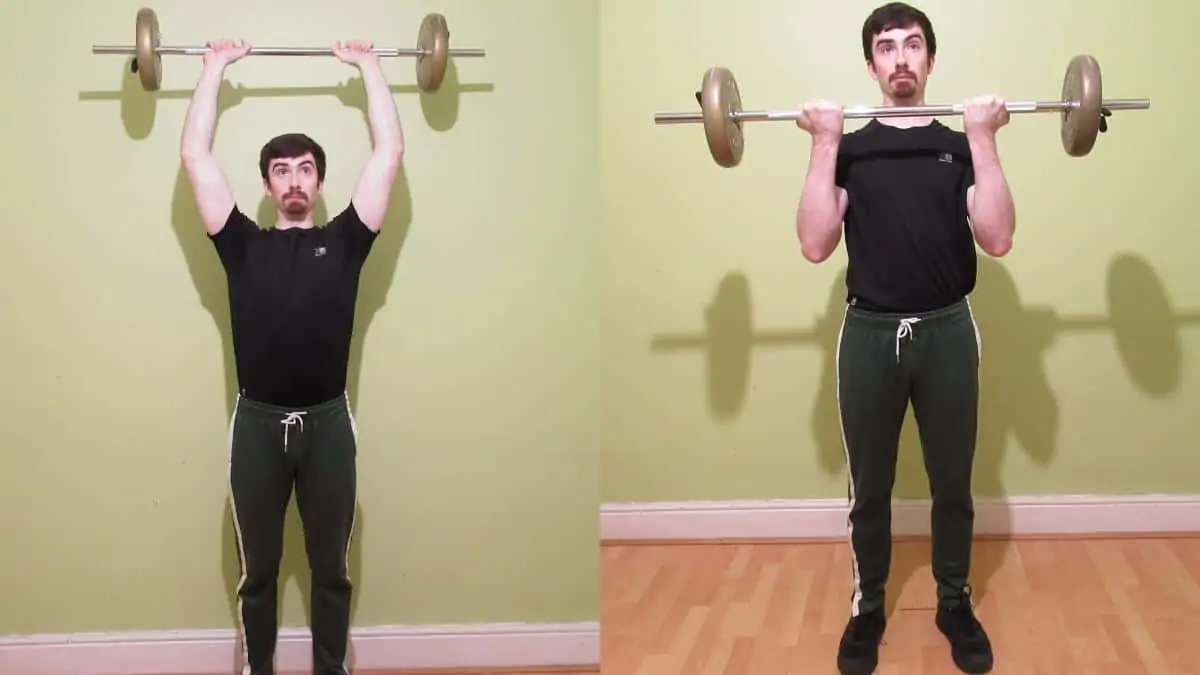Understanding what the biceps do—flex the elbows, supinate the forearms, assist with shoulder flexion—will help you to gain muscle because you’ll be able to select the most optimal exercises and thus create the best bicep workout possible.
So, in addition to crafting some shoulder and bicep workout routines, we created a rundown of the most effective exercises for these two muscles so that you can design your own program if you so desire.
Related: Shoulder and forearm workout│Tricep and shoulder workout
Create your shoulder and bicep workout
The first three movements in this list are shoulder bicep exercises in that they work both the deltoids and the biceps simultaneously. These drills are a great, time-saving way to achieve an intense bicep and shoulder workout without living in the gym.
The other exercises consist of muscle-specific movements that you can pair together in a superset fashion or perform linearly within a traditional bicep shoulder workout routine.
1. Hammer curl to press
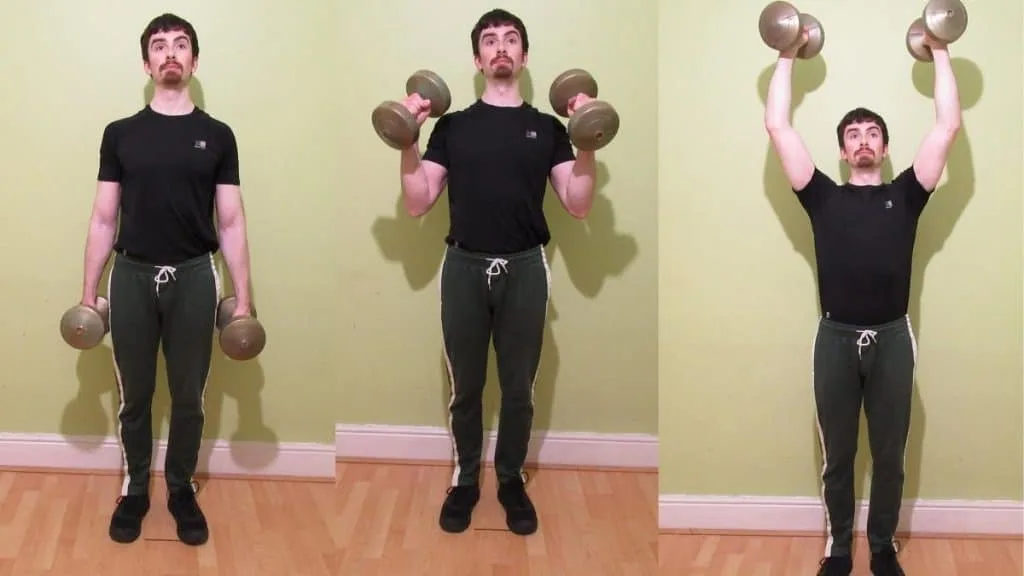
The hammer curl to shoulder press works your biceps, brachialis, brachioradialis, deltoids, and triceps. Considering that regular curls pretty much just train the biceps, you quickly begin to realize just how time-efficient this high-intensity hammer cur hybrid really is.
It’s the ideal movement to finish off your biceps and delts after a hard and heavy workout. That’s right; I said to finish off. Don’t use the hammer curl to press as your primary exercise if you’re trying to gain maximum mass (if you just want to gain some muscle, then, by all means, make it your main movement).
This is because you can typically shoulder press more weight than you can hammer curl. So by combining the exercises together, your arms will naturally fatigue before your deltoids, which means that your shoulders won’t achieve complete stimulation.
- Hold a pair of weights by your sides with a neutral grip.
- Curl the dumbbells toward your shoulders until your biceps and forearms make firm contact.
- Press the weights over your head until your elbows are locked out.
- Reverse the motion by lowering the weights back down to your shoulders.
- Finish the rep by lowering the dumbbells back to your sides under control (don’t just let them drop).
- Repeat for 3-5 sets of 8-15 reps.
2. Bicep curl to press
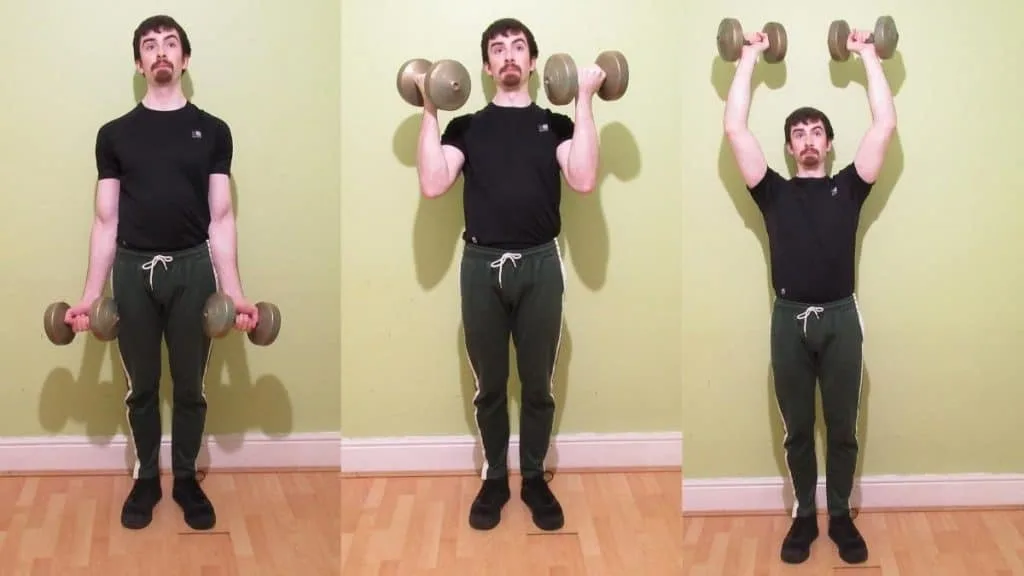
Performing the bicep curl and press is another efficient way to sculpt your shoulders and blast your biceps because you’re combining two movements into one exercise.
Therefore, the curl to press can also provide a good cardio workout if you perform high enough reps.
On the other hand, if you’re training for mass gain, then you’ll want to perform lower reps with heavier weights to focus on strengthening the fast-twitch muscle fibers (i.e., the fibers that grow the biggest).
- Hold a dumbbell in each hand with a supinated (palms-up) grip.
- Curl the weights toward your front delts.
- Keep lifting until your forearms press up against your biceps.
- Press the dumbbells over your head until your elbows reach full extension.
- Reverse the motion by lowering the weights down to your shoulders.
- Then lower the dumbbells back down to your sides by resisting the weights with your biceps.
- Perform 3-5 sets of 8-15 reps.
3. Dead curl press
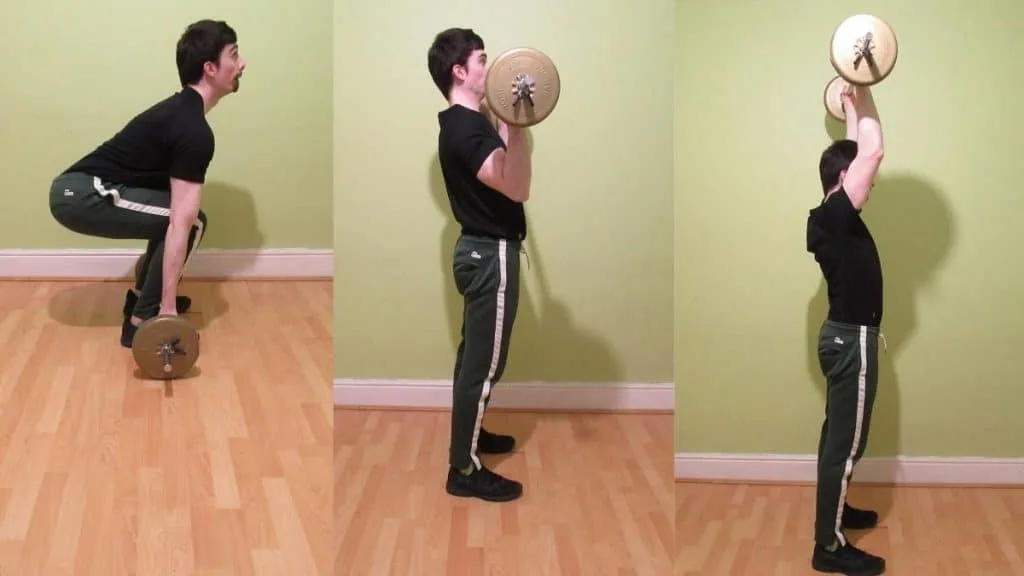
Performing the dumbbell or barbell dead curl press is a great way to get your heart pumping and your muscles burning. The trick is to perform fast repetitions so that you can burn the most amount of calories while recruiting the fast-twitch muscle fibers.
As such, the dead curl press is an excellent exercise for cutting phases and weight loss workouts. It’s also an effective way to end regular bicep and shoulder workouts because it trains both the deltoids and the biceps simultaneously.
- Load some weights onto a barbell and then stand in front of the bar.
- Push your hips back and bend your knees.
- Grab the bar with an underhand grip just inside shoulder-width.
- Deadlift the bar off the floor by pushing your feet into the ground.
- Thrust your hips forward while driving your chest up and back as the weight comes off the floor.
- Then, curl the bar toward your chest.
- Press the weight over your head until your arms are locked out.
- Reverse the motion by lowering the bar back down to your shoulders, then to your hips, and finally, back down to the ground.
- Repeat for 3-5 sets of 8-15 reps.
4. Overhead press
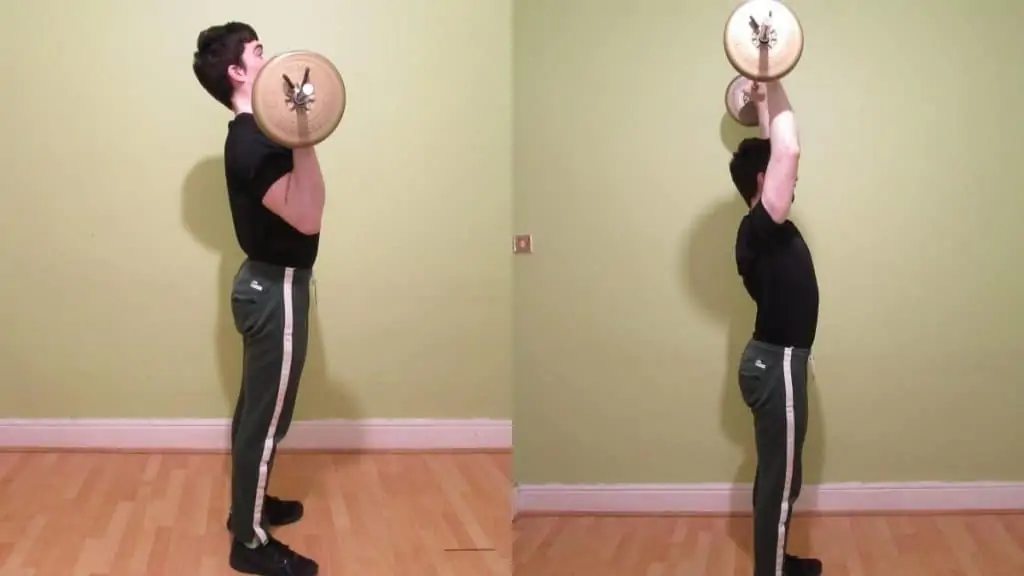
If you want to develop rock-solid deltoids and powerful pressing strength, then make sure to include the overhead press in your shoulder bicep workout. It’s a great exercise to do if you train at home or have limited equipment because all you need is a bar and some weights.
You can also do the OHP while sitting down to reduce the core stability requirement of the exercise. However, it’s very difficult to un-rack the bar from a shoulder press station unless you have a spotter. So, for this reason—and the fact that military pressing just makes you feel strong—it’s recommended to do the shoulder press in a standing position.
- Place a barbell into a rack at just below shoulder height.
- Load some weight onto the bar and then grab the bar with an overhand grip just inside shoulder-width.
- Breathe in and tighten your core.
- Press the bar over your head until your elbows reach full extension.
- Exhale and reverse the motion by lowing the bar back down to your chest.
- Repeat for 3-5 sets of 5-10 reps.
5. Lateral raise
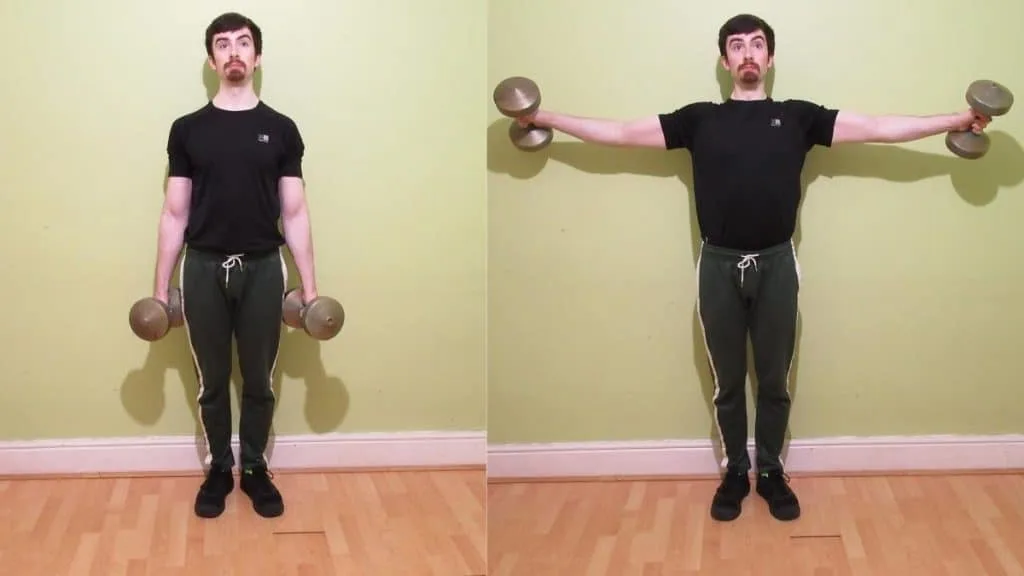
You can never have side delts that are too big—especially because the front delts already get so much work from heavy presses. That’s why any good bicep and shoulder workouts should always include some kind of lateral raise.
Just make sure that you don’t internally rotate your shoulders during lateral raises. While turning your pinkies up will increase side delt activation a bit, you’ll also massively increase your risk of getting a shoulder impingement; then you won’t be doing any lateral raises. So train smart and avoid internal rotation. Since lateral raises are an isolation exercise, you’re going to feel your side delts working regardless.
- Hold two relatively light dumbbells by your sides with an overhand grip.
- With a slight bend in your elbows, raise the weights out to the sides until your shoulders form a 90-degree angle with your torso. Avoid raising the weights beyond 90 degrees.
- Hold the contraction for a second, and then slowly lower the dumbbells back to your sides.
- Perform 3-5 sets of 12-20 reps.
6. Barbell preacher curl

Performing the preacher barbell curl during your biceps and shoulder workout helps you to curl with the proper form. This is useful if you’re a beginner or if you just tend to cheat the weight up when you curl. After all, when your arms are braced against the preacher pad—and when you’re sat on the seat with your feet on the floor—you couldn’t swing the bar up with your shoulders, legs, or back even if you wanted to.
Similarly, the fact that you’re using a straight bar rather than an EZ bar means that your wrists are in a fully supinated (as opposed to a semi-supinated) position. This grip places maximum tension on the biceps because, in addition to elbow flexion, the biceps’ other primary function is forearm supination, i.e., turning your palms up.
- Load some weight onto a barbell and place the bar in the preacher rack. Consider using a preloaded bar if it’s more convenient.
- Sit on the seat and brace your arms against the preacher pad.
- Grab the bar with a shoulder-width underhand grip.
- Curl the bar toward your front delts.
- Keep lifting the weight until the undersides of your forearms press right up against your biceps.
- Hold the contraction for a second, and then lower the barbell under control until your elbows are locked out.
- Repeat for 3-5 sets of 8-12 reps.
7. Lying cable curl
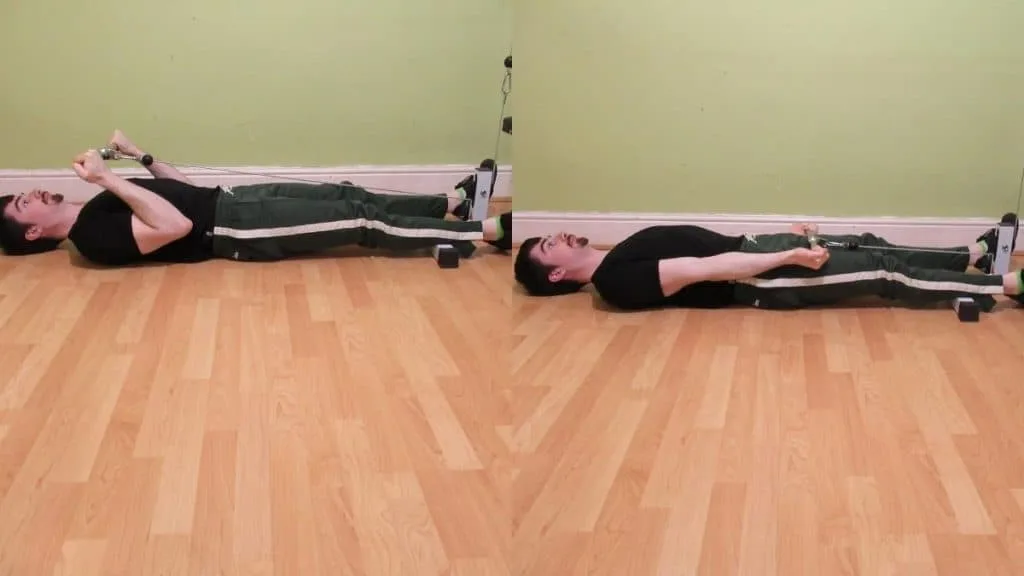
Lying cable biceps curls are a bit more complicated to set up than the other exercises because you need access to a cable machine and space to lie down. The resulting bicep pump and contraction, however, will be worth the effort.
Since lying cable curls train your biceps at a very short muscle length (i.e., when your shoulders are in front of your toros and thus in flexion), the peak contraction naturally becomes a lot more intense.
As such, this variation of lying cable curls is an excellent way to end a shoulders and biceps workout after you’ve already done heavy free-weight exercises.
You can enhance the peak contraction further still by doing this exercise while lying on a weight bench and curling the cable attachment to your forehead. Cable close grip curls are another good option in this regard, and they also emphasize the long (outer) head of the biceps.
- Connect a straight bar attachment to a low pulley.
- Sit in front of the pulley and grab the bar with an underhand grip.
- Lie back on the floor so that the bar is now resting on your thighs.
- Curl the bar toward your chest.
- Squeeze your biceps as hard as you can as they push up against your forearms.
- Hold the peak contraction for a brief moment.
- Release the bar under control until your elbows reach full extension.
- Repeat for 3-5 sets of 10-15 reps.
8. Rear delt fly
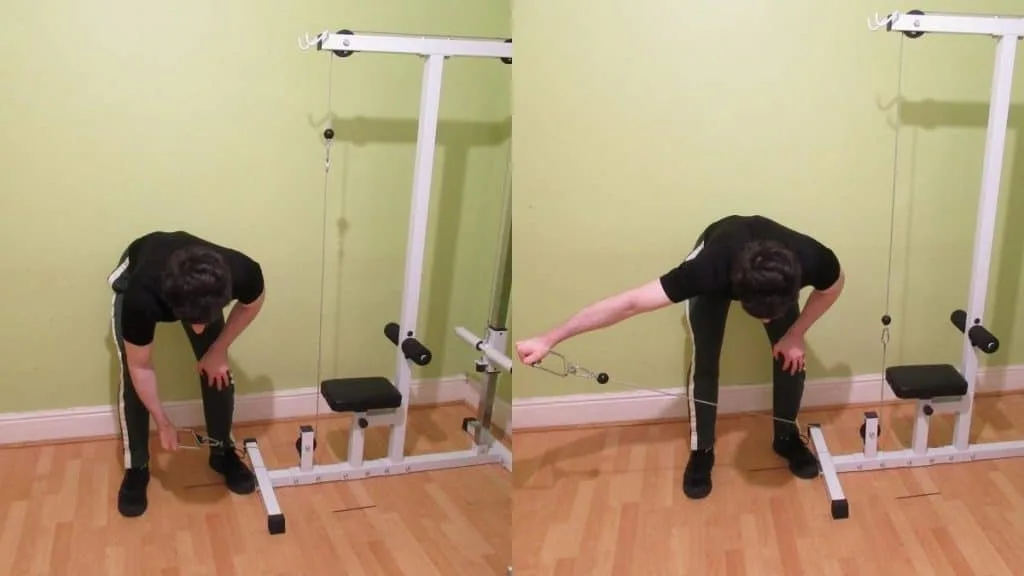
If you want a complete physique, then you need to build your rear delts so that your shoulders look well-developed from all angles, not just from the front.
Performing a rear delt fly with cables means that your posterior delts get muscle-building tension at all parts of the rep.
With the free weight version, on the other hand, the rear delts only really become active once they’re maximally contracted, which is to say at the very end of the rep. So use cables (or bands) if you have access to them.
- Position a cable column at shoulder height and remove any attachments.
- Grab the end of the cable (the ball part on most machines) with an overhand or neutral grip.
- Protract your scapula (shrug forwards basically) to take your traps more or less out of the equation.
- While maintaining this protracted position, move your shoulder to the side in a reverse fly motion.
- Keep going until you feel a strong contraction in your rear delt.
- Reverse the movement so that your hand is now back in front of your torso.
- Repeat with your other arm and perform 3-5 sets of 12-20 reps. You can also train both sides together if you have access to a cable crossover.
9. Seated reverse dumbbell curl
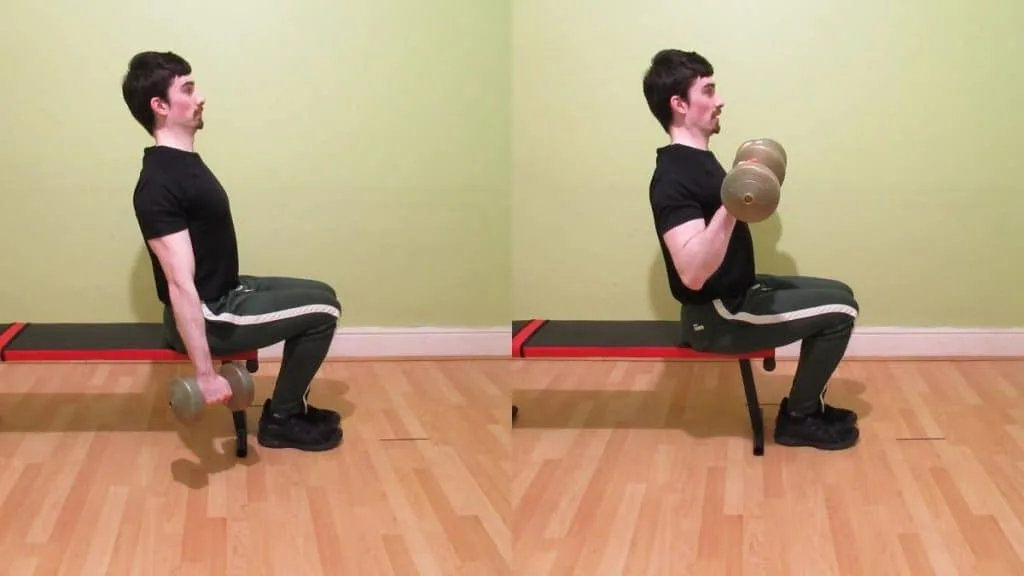
The seated reverse dumbbell curl is a brilliant addition to any shoulder and biceps workout routine because it trains two critical arm muscles—the brachialis and the brachioradialis—that most lifters usually neglect in favor of the biceps.
Performing your reverse curls seated also reduces the core stability requirement of the exercise and thus makes it easier to keep the tension on the target muscles.
Similarly, using dumbbells minimizes your chances of developing muscular imbalances and strength disparities between your arms.
- Grab a pair of dumbbells and hold them by your sides with a thumbless overhand grip.
- Sit on the bench, ideally with your back braced against the back pad.
- Curl the weights toward your shoulders while keeping your elbows still.
- Keep curling the weights until the tops of your forearms make firm contact with your biceps.
- Hold the contraction for a second, and then lower the weights back down until your arms are locked out.
- Repeat for 3-5 sets of 10-15 reps.
The best shoulder and bicep workout routines for building muscle
Each of these biceps and shoulders workout routines has a different theme. For example, there’s a routine for beginners and intermediates, and also a workout that focuses on maximizing strength gain.
Alternatively, for a high-volume, mass-gaining workout, you can simply perform straight sets (or even supersets) using all or some of the exercises listed above.
To work more muscles in your upper body within the same session, consider doing a shoulder back and bicep workout. Of course, you can always pair lats and traps with another body part (like the chest) on a different day instead.
The beginner and intermediate bicep and shoulder workout

1: Overhead press — 3-5 sets of 6-10 reps
2: Preacher curl — 3-5 sets of 8-10 reps
3: Lateral raise — 3-5 sets of 12-15 reps
4: Reverse curl — 3-5 sets of 12-15 reps
5: Face pull — 3-5 sets of 15-20 reps
This bicep and shoulder workout is ideal for novice and intermediate lifters who are seeking to add size to their physique. If you’re a beginner, stick with 3 sets per exercise; intermediates can do 3-5 sets on each movement depending on their volume tolerance.
The overhead press is the first exercise. You can do it with a barbell or dumbbells, seated or standing, free weight or machine—it doesn’t really matter. While I most recommend the standing barbell version (it just feels badass), you can use any equipment providing that you lift with the proper form.
Preacher curls are the second exercise, and they’ll provide maximum bicep isolation as long as you use a full range of motion.
Then it’s on to lateral raises to improve your shoulder width. Again, you can use cables, dumbbells, or even bands. What matters most is that you feel your side delts working.
The reverse curl ensures that you build good overall arm size (not just bulging biceps) by targeting the often neglected brachialis and brachioradialis muscles. Building your brachialis can actually push your biceps out (because the brachialis is a deep muscle) and make them appear more peaked.
Finally, our bicep shoulder workout ends with face pulls to build the rear delts and strengthen the rotator cuffs— two areas that you should never skip if you want to build healthy, muscular shoulders.
Rest 2-4 minutes between sets (less time on isolation exercises, more time on compound movements).
The superset shoulder and bicep workout
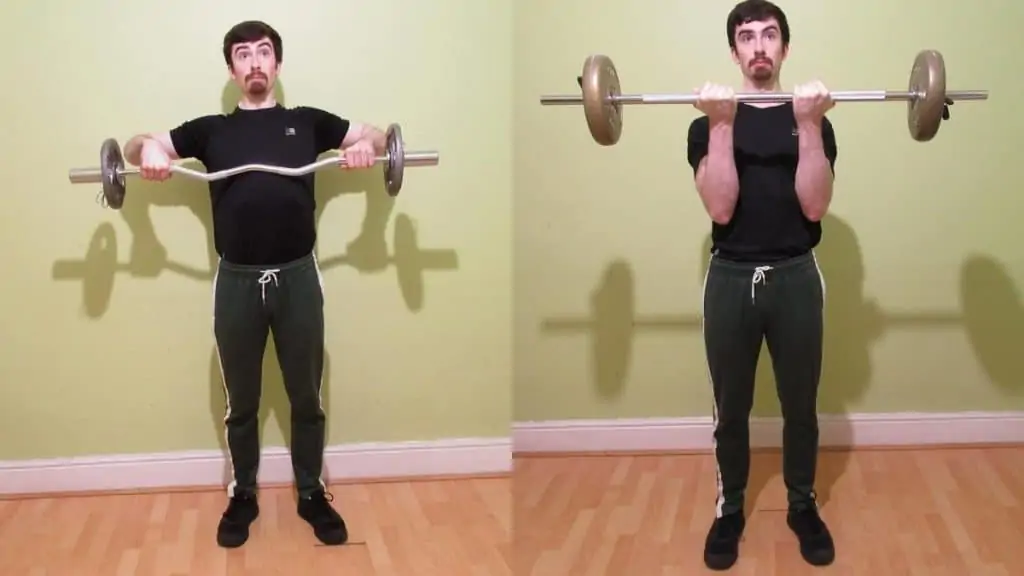
1A: Shoulder press — 3-5 sets of 8-10 reps
1B: Close-grip barbell curl — 3-5 sets of 8-10 reps
2A: Wide grip upright row — 3-5 sets of 10-12 reps
2B: Wall curls — 3-5 sets of 10-12 reps
3A: Lateral raise — 3-5 sets of 12-15 reps
3B: Hammer curl to press — 3-5 sets of 12-15 reps
This is the best shoulder and bicep workout for advanced lifters who want to get a great pump. It’s a very intense routine, so make sure that you have a solid foundation of size before attempting it.
To make things easy to set up, we paired exercises together that use the same equipment. This way, you don’t need to waste any time and energy between sets on gathering your training tools.
That said, you may still need to change the weights a bit. For example, you can probably shoulder press more than you can bicep curl.
You can perform the supersets back-to-back or take a 30-60 second rest to catch your breath. Since these aren’t supersets for the same body part, it’s not like you have to perform them in immediate succession to maintain your pump.
Rest 2-3 minutes between each cluster of supersets.
The strength-focused biceps and shoulders workout
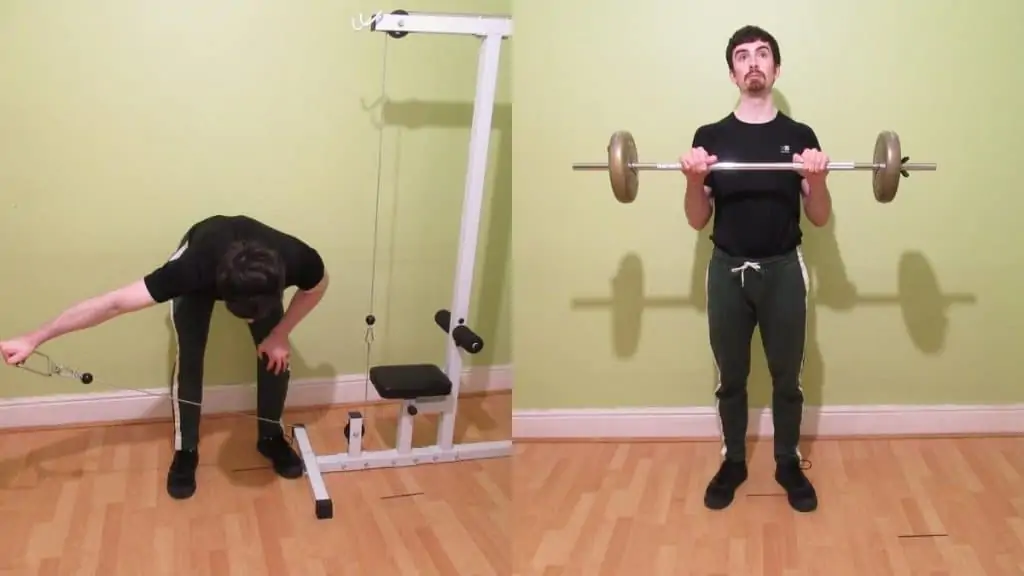
1: Overhead press — 4-6 sets of 4-7 reps
2: Upright row — 4-5 sets of 8-10 reps
3: Rear delt fly — 3-5 sets of 12-15 reps
4: Wall curl — 4-6 sets of 6-8 reps
5: Reverse curl — 4-5 sets of 10-12 reps
If you want to build strong shoulders and biceps while adding muscle to your upper body in the process, then this is the best routine for you.
The exercise selection is similar to that of the workouts listed above; the difference is that you’ll be performing mainly low reps. This way, you can train your central nervous system to become more efficient at lifting heavy weights.
Since you’re training for maximum strength, rest 3-5 minutes between sets on compound movements (overhead press and upright row). On the isolation drills, a 2-3 minute recovery period will suffice.
Also, try to leave one rep in the tank on each set. If you train to failure, then you’ll fry your central nervous system and make yourself weaker for the rest of the workout. It’s critical to remember that you need to build strength (i.e., perform multiple sets of low reps without hitting failure) before you can display that strength by setting new PRs.
Should you train shoulders and biceps on the same day?
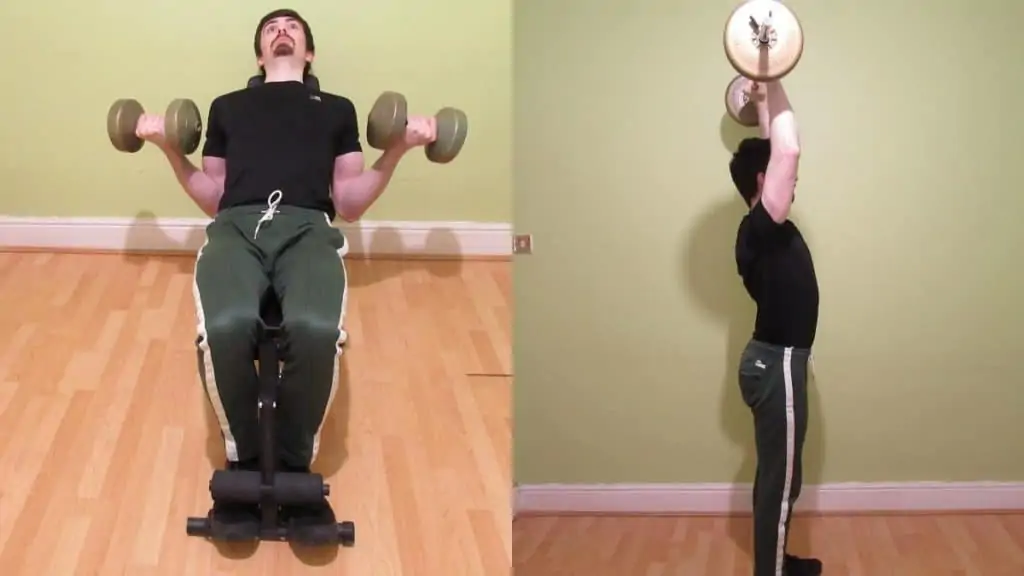
Yes, you can train shoulders and biceps on the same day and gain muscle mass and strength. The first approach that you can take is to perform all of your shoulder exercises, followed by all of your bicep exercises. This setup is the most common and lets you perform your compound movements (such as shoulder press) when you’re at your freshest.
Alternatively, you can actually do all of your bicep movements first if your biceps are underdeveloped in comparison with your shoulders. Just be aware, however, that since the biceps help to stabilize the shoulders to a small degree, you might actually be a bit weaker on your shoulder exercises if you train biceps first.
A third option is to perform the exercises in a superset fashion. This setup saves you time in the gym but is far more intense. You may also feel weaker if you follow the superset approach because this back-to-back training style has a sizable cardiovascular component to it (at least compared to straight sets).
You could also do a chest and bicep workout instead since those two body parts also have minimal—if any—cross-over.
Conclusion: How to strengthen your shoulders and biceps
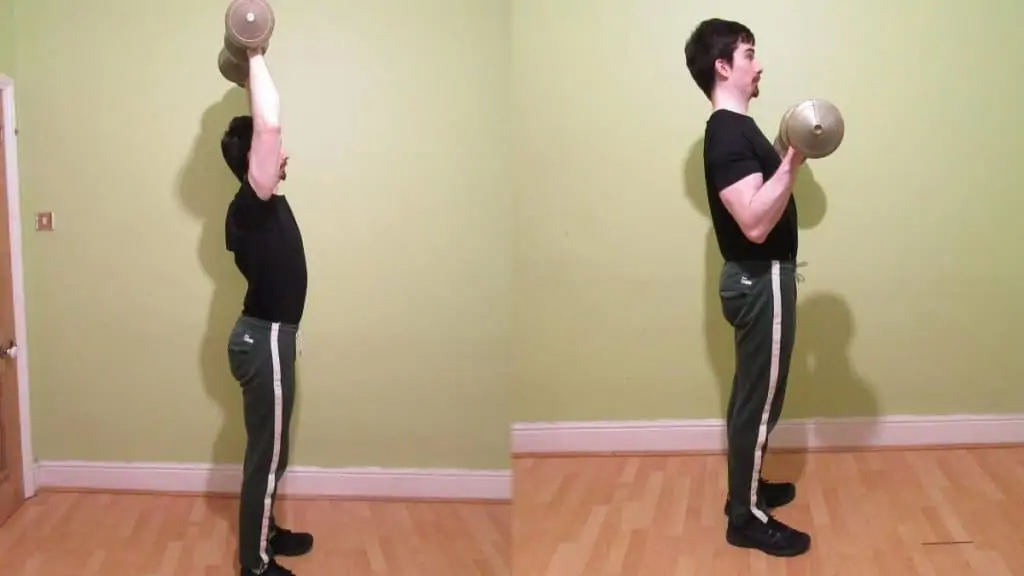
Sculpting a strong set of shoulders and building a bulging pair of biceps can dramatically enhance the appearance of your upper body. Yet, physique transformations of this magnitude require a critical approach to exercise selection; you can’t expect to gain masses of muscle from doing a random concoction of exercises.
If you’ve been in the gym for a while, then you can always create your own custom shoulder and biceps workout routine from our list of exercises, or you can simply perform them all if you’re seeking a high-volume workout.
On the other hand, you can follow one of our trainer-designed shoulder and bicep workout routines if you just want to get on with lifting. These are the routines that you saw in the workouts section of this guide, and they’ll completely remove the guesswork from figuring out which exercises are optimal for each region of the shoulders and biceps.

